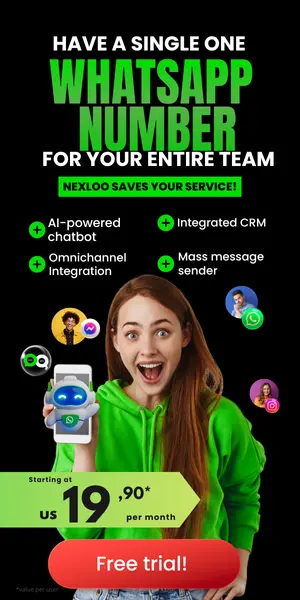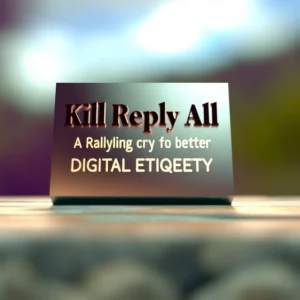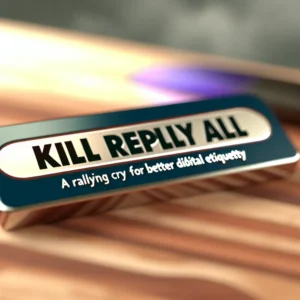In a world increasingly driven by technology, understanding and practicing digital etiquette has become crucial for ensuring effective communication in the workplace. Every day, we navigate a myriad of digital channels, from emails to instant messaging, each with its own unwritten rules. Failing to grasp these nuances can lead to miscommunication, misunderstandings, and an atmosphere that hinders productivity.
Do you often find your inbox flooded with unnecessary replies? Are you overwhelmed by endless chains of “Reply All” messages? You’re not alone. Many professionals struggle to maintain clarity amidst the chaos of digital communication. However, by honing your digital etiquette skills, you can help foster a more respectful and efficient workplace environment.
Digital etiquette isn’t just about following rules; it’s about enhancing workplace communication and creating a culture where everyone feels heard and valued. By being mindful of your interactions, you not only improve your professional relationships but also contribute to a positive, thriving workplace.
What is Digital Etiquette and Why Does It Matter?
Digital etiquette, often called “netiquette,” comprises the unwritten rules of acceptable online behavior. This guide helps you navigate the vast digital landscape experienced daily. In an age of overwhelming email communication, understanding how to practice good digital etiquette can save everyone from drowning in ineffective exchanges.
A core aspect of digital etiquette involves email management. Colleagues and clients rely on emails to communicate effectively. You optimize this interaction by knowing when to hit “Reply All” or when to respond individually. A well-timed “Reply All” can foster teamwork, while a misused one can spark chaos. Discerning which correspondence merits collective attention is a valuable skill.
Consider the case of Clínica Vitalis, which enhanced their email communications through digital etiquette training. As a result, they reported a 40% reduction in unnecessary replies, leading to a more organized inbox and increased focus on critical messages.
Digital etiquette extends beyond emails. You must also be mindful of your tone, respect privacy, and choose the right platforms for specific discussions. What may seem like a fun group chat can quickly devolve into a noisy exchange that overshadows important ideas. Using established channels for relevant conversations enhances focus and productivity.
Moreover, adopting good digital etiquette fosters a respectful workplace culture. It shows your colleagues that you value their contributions, ultimately strengthening team dynamics. A simple acknowledgment, such as “thank you,” can enhance interaction, turning a standard email exchange into a moment of collegiality.
The Dangers of Reply All: A Comedy of Errors in Workplace Communication
Misusing the “Reply All” function is akin to shouting in a crowded room; it can lead to embarrassing moments. Imagine a colleague sharing vacation photos with the entire company, inundating everyone’s inboxes with personal snapshots instead of essential project updates. This situation accentuates the necessity for better digital etiquette.
While “Reply All” exists to facilitate collaboration, it often becomes the source of chaos, demonstrating a lack of understanding of effective communication. Each click can result in an avalanche of unnecessary threads, further distracting from important tasks.
Take the misstep of an employee who replied to a sensitive discussion with a casual “Thanks, team!”—unintentionally including their manager. Such incidents may provide comedic relief but also emphasize the significance of recognizing when and how to use “Reply All.” This understanding preserves professionalism in workplace communications.
It’s vital to realize that humor may not resonate with everyone. What might seem funny to one colleague could be disruptive or offensive to another. Cultivating awareness around digital etiquette helps eliminate misunderstandings and promotes respectful practices.
Encouraging employees to pause and reflect before responding can reduce unnecessary replies and foster more effective interactions. Maintaining professionalism through proper email etiquette not only eases communication but cultivates a more enjoyable and productive work environment.
Essential Digital Etiquette Tips for Emails
Navigating emails can feel like a minefield. Start by thinking critically before hitting “Reply All.” Use this function sparingly and only when each recipient genuinely needs to see your comment. This practice can prevent overflow in inboxes and maintain the focus of conversations.
Clarity is key in professional communication. Craft subject lines that reflect the email’s purpose clearly. For example, “Quick Update on Project X” is far superior to a vague “Hi.” Well-defined subject lines help colleagues prioritize responses effectively.
Keep your messages concise yet captivating. Lengthy explanations may cloud important details. Use bullet points or numbered lists to enhance readability and ensure your recipients grasp the main points quickly.
Be considerate of your tone and language. Overly technical jargon can alienate readers unfamiliar with the subject matter. Adapt your vocabulary to suit your audience, fostering understanding and inclusivity. Often, straightforward language conveys messages more efficiently, improving professional skills across the organization. Consider exploring automated solutions to enhance your messaging.
In addition, timing impacts your communication’s effectiveness. Avoid sending emails late at night or during weekends, unless urgent. Respect your colleagues’ personal time, showing professionalism and consideration for their work-life balance.
Beyond Emails: Navigating Digital Etiquette Across Platforms
Digital etiquette stretches beyond email into the wider online realm. As workplace communication evolves, so must our understanding of how to engage with various platforms. A single poorly worded message can cause confusion among team members. Mindfulness is essential across all communications.
For example, the classic email faux pas is hitting “Reply All.” This behavior clutters inboxes and raises frustrations. Always consider the email’s context. If your reply is only relevant to one recipient, direct it to them exclusively to enhance communication and productivity.
Chat platforms like Transportadora Prime have different etiquette challenges. The informal nature can lead to misinterpretation. While GIFs and emoticons can enliven discussions, they also risk being incongruous. Think before sending memes; your idea of humor might not be universally appreciated.
Video calls have become integral to modern meetings, yet basic etiquette is often forgotten. Dress appropriately, ensure a professional background, and mute yourself when not speaking. These small professional touches demonstrate respect for your colleagues’ time and attention.
Social media also requires a vigilant approach to unwritten rules. Although sharing achievements on these platforms may be tempting, recognize the boundaries between personal and professional content. Oversharing can have lasting consequences, so maintain discretion in your posts.
Professional Skills That Enhance Your Digital Etiquette
Grasping digital etiquette is vital in today’s workplace communication landscape. Employees must adeptly navigate multiple platforms while avoiding the dreaded “Reply All.” Developing essential professional skills can enhance your digital practices and relieve communication burdens.
Start by mastering concise communication. Brevity respects your colleagues’ time and ensures clarity. When drafting emails, aim to relay your message straight away. Utilize bullet points and headers to organize thoughts—this technique promotes readability.
Understanding tone nuances enhances digital etiquette. Without visual cues, emails can be misinterpreted. To refine your etiquette, consider how your words may come across to the reader. Emojis and light-hearted jokes can shift tone positively, but utilize them wisely to prevent misunderstandings.
Knowing when to use “Reply All” is often underestimated. Evaluate whether every recipient truly needs your input. Before clicking, ask: does my response add value to the group? This consideration streamlines communication and enhances digital etiquette, leaving a positive mark on colleagues.
Time management likewise improves digital etiquette. Respecting others’ time reflects professionalism. By acknowledging when emails should receive immediate replies and when they can wait, you help create a culture of efficiency.
Creating a Culture of Better Communication: Tips for Teams
Establishing a culture of digital etiquette begins with recognizing how our communication habits impact workplace dynamics. Whether in emails, chats, or video calls, interactions can significantly influence professional relationships. Establishing clear norms around communication proves vital for team alignment.
Email Etiquette Essentials
Emails can easily become cluttered spaces of miscommunication. Start by promoting concise subject lines that summarize content effectively. This simple act aids recipients in prioritizing responses. Additionally, encourage colleagues to think twice before hitting “Reply All.”
Mastering Workplace Communication
Communication in the workplace demands nuance. Provide guidance on when to use distinct tools. For example, address quick questions via instant messaging, while reserving detailed discussions for emails or meetings. Mindful selection of mediums amplifies clarity and efficiency.
Throw in a Dose of Humor
Humor possesses the potential to enhance message delivery. Instead of providing dry reminders about etiquette, share light-hearted memes or anecdotes to illustrate common pitfalls. Engaging employees in this way fosters a relaxed atmosphere surrounding communication norms.
Professional Skills Development
Investing in communication-related professional skills can yield positive outcomes. Host workshops on effective emails, active listening, and articulating thoughts during conversations. Equipping teams with these competencies enhances collaboration and reduces misunderstandings.
The Future of Workplace Communication: Evolving Digital Etiquette
The role of digital etiquette has gained significance in the contemporary workplace. As remote work becomes prevalent, the ability to convey messages respectfully through email and other platforms is crucial. Employees must adapt to evolving communication styles, ensuring a positive work environment.
Practices like curbing excessive “Reply All” messages play a part in digital etiquette. These behaviors not only annoy coworkers but also hinder productivity. Encouraging concise and purposeful exchanges supports more efficient communication, reducing the time spent sifting through irrelevant emails.
With the rise of instant messaging tools, workplace communication continues evolving. Employees can utilize these platforms to foster a more casual yet professional atmosphere. Quick updates can now be communicated instantly, fostering transparency and collaboration.
As digital etiquette forms a foundational component of professional skills, employees must develop consciousness around tone and context when communicating online. Recognizing potential misinterpretations leads to better relationships and prevents conflicts.
As organizations adopt omnichannel support platforms, the integration of digital etiquette becomes paramount. These tools facilitate communication across various channels, necessitating consistent etiquette approaches. Promoting a culture of respect and clarity boosts morale and productivity, allowing organizations to leverage their communication capabilities.
Join the Movement for Better Digital Etiquette!
Amidst technological advancement and the digital communication revolution, digital etiquette has become a cornerstone for seamless interactions in the workplace. As team members, it is our duty to cultivate a virtual space where communication remains clear, respectful, and effective.
Embracing digital etiquette principles means enhancing our interactions, especially via email, and avoiding unnecessary misunderstandings. Consider the impact of “killing Reply All.” Excessive use of this feature clogs inboxes and detracts from effective communication in the workplace.
Moreover, improving professional skills includes mastering digital etiquette. By avoiding inappropriate practices, like lengthy email threads, we not only optimize communication but also respect our colleagues’ time and efforts.
Let’s not underestimate the impact our communication has. A single gesture, like minimizing mass replies, can significantly affect the perception and well-being of everyone in the workplace. Together, let’s prioritize digital etiquette in our interactions!
By aligning our digital communication, we take steps towards a workplace where everyone feels heard and respected. Join us in advocating for better digital practices—your inbox and colleagues will thank you! Explore tools to enhance your omnichannel support.









